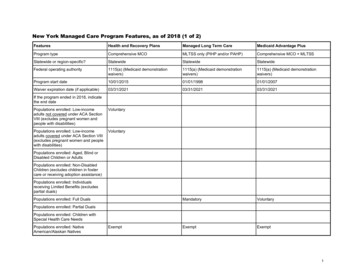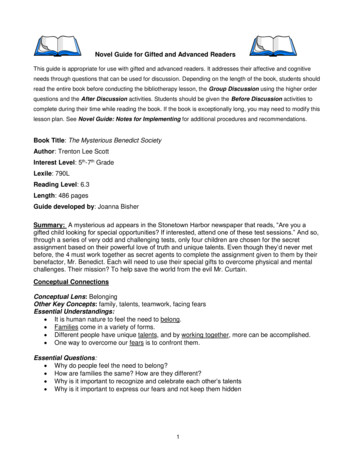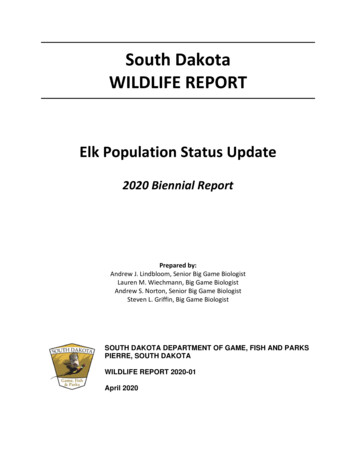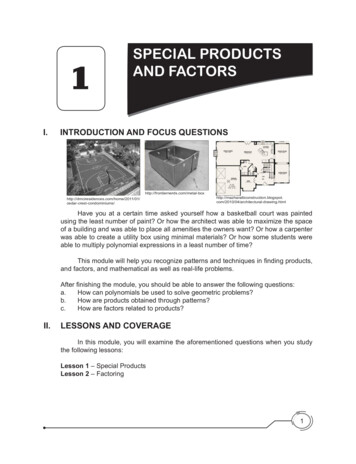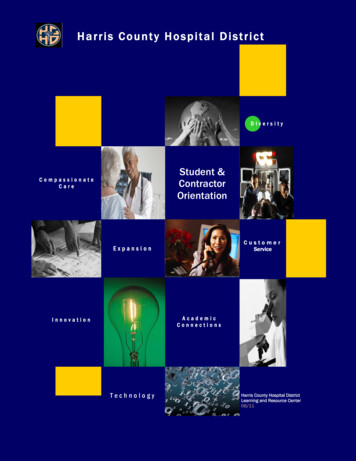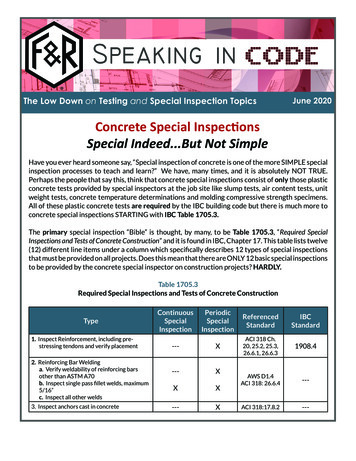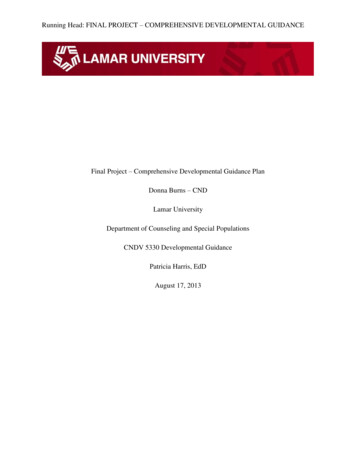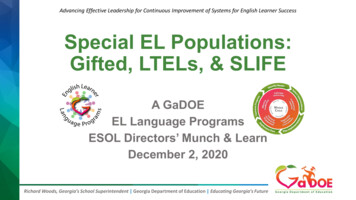
Transcription
Advancing Effective Leadership for Continuous Improvement of Systems for English Learner SuccessSpecial EL Populations:Gifted, LTELs, & SLIFEA GaDOEEL Language ProgramsESOL Directors’ Munch & LearnDecember 2, 2020Richard Woods, Georgia’s School Superintendent Georgia Department of Education Educating Georgia’s Future
Connect toPriorLearning!Richard Woods, Georgia’s School Superintendent Georgia Department of Education Educating Georgia’s Future
Richard Woods, Georgia’s School Superintendent Georgia Department of Education Educating Georgia’s Future
Lunch Menu TodayAppetizer Review November session Federal requirementsMain Course College Readiness & TalentDevelopment LTELs SLIFE & MigrantDessert WIDA & ESOL ResourcesRichard Woods, Georgia’s School Superintendent Georgia Department of Education Educating Georgia’s Future
14224352Richard DearWoods,ColleagueGeorgia’s SchoolSuperintendent GeorgiaDepartmentEducationEnglish EducatingGeorgia’sFutureOCR/DOJLetter:English LearnerStudentsandofLimitedProficientParents2
Providing ELs with a Supportive LearningEnvironment1. College Readiness & Talent Development (GIFTED) GaDOE Program Specialist, MaryJean Banter2. Long-term English learners (LTELs) Effingham County School District3. Potential LTELs Rome City Schools4. Migratory ELs who are SLIFE Federal Programs, Title I, Part CRichard Woods, Georgia’s School Superintendent Georgia Department of Education Educating Georgia’s Future
Percent of FY20 English Learners who are .Gifted 0.57% GiftedELs (749 ELs*) 0.04% Servedin ESOL &Gifted (56 ELs)LTELs 1.05% ELssince 2004 2015 (1351ELs)SLIFE No data LEA defined*An FY19 data report indicates there were 3313 ELs served in gifted programs.Richard Woods, Georgia’s School Superintendent Georgia Department of Education Educating Georgia’s Future
College Readiness & Talent Developmentfor English LearnersMaryJean BanterProgram SpecialistOctober 7, 2020Educating Georgia's Future by graduating students who are ready to learn, ready to live, and ready to lead.8
College Readiness and TalentDevelopment TeamGail Humble, ghumble@doe.k12.ga.usProgram ManagerAlison Coker, acoker@doe.k12.ga.usConsultantMartha Smith, masmith@doe.k12.ga.usProgram SpecialistMary Jean Banter, mbanter@doe.k12.ga.usProgram Specialist9Richard Woods, Georgia’s School Superintendent Georgia Department of Education Educating Georgia’s Future
Talent Development – Programs & SupportSupporting Gifted Education FY 21 Regional Virtual Gifted Workshops for District Leaders: (16 TrainingOpportunities) FY21 Gifted Workshops for New District Gifted Leaders (at least 8 TrainingOpportunities) Monthly conference calls with new gifted coordinators (5 years of experience or less) Gifted Editors—Gifted Teachers who are developing enhancements to align withthe new K-12 Remote Learning Plans for gifted/high ability learners edWeb Community for Georgia New Gifted Coordinators Gifted Virtual Specialists – Georgia gifted endorsed teachers will provide virtual trainingfor Georgia gifted teachers 4X/year concentrating on some of our main service deliverymodels and Creativity Creation of Gifted Information Support Google Site for District Gifted CoordinatorsRichard Woods, Georgia’s School Superintendent Georgia Department of Education Educating Georgia’s Future
Talent Development – Programs & Support Creation of Go-To-Meeting Information Sessions Documents for Guidance/support for scenarios for virtual gifted service deliverymodels Podcast(s) – Well Being of our Gifted and High Ability Learners, etc. Gifted Task Force with Working Groups (Culturally Responsiveness and TalentDevelopment) Gifted Education Webpage Educating the Whole Child Resources: Supporting a Learner’s Potential Georgia Association for Gifted Children Virtual Convention March 1-2, 2021 National Association for Gifted ChildrenRichard Woods, Georgia’s School Superintendent Georgia Department of Education Educating Georgia’s Future
Gifted EL StudentsSuggestions for districts to support the growth of theidentification of Gifted EL students: Adopt Universal Screening Procedures Create Pathways to Identification (include portfoliosproducts/performances) Establish Open Communication with Parents, ESOL Teachers,Title III leaders Conduct Professional Development that includes how to haveCulturally Responsive Classrooms and Talent DevelopmentExploratory Study on the Identification of English Learners for Gifted and TalentedPrograms http://ncrge.unconn.eduRichard Woods, Georgia’s School Superintendent Georgia Department of Education Educating Georgia’s Future
Ethnicity of GA’s Gifted 293105,26210% ofTotal StdPop.10.2% ofTotal Std.Pop.201910.3% ofTotal St.Pop.202010.4% ofTotal St.Pop.Multi12/1/2020 Richard Woods, Georgia’s School Superintendent Georgia Department of Education Educating Georgia’s Future8,36913
What research is available to help usidentify and serve Gifted list/oela/index.htmlRichard Woods, Georgia’s School Superintendent Georgia Department of Education Educating Georgia’s Future
Richard Woods, Georgia’s School Superintendent Georgia Department of Education Educating Georgia’s Future
Follow us on Twitter@GaDOECollegeRdyand use#collegereadyGA to celebratesuccessesRichard Woods, Georgia’s School Superintendent Georgia Department of Education Educating Georgia’s Future16
Long-term English learners(LTELs)Ms. Kristie Long, ESOL CoordinatorEffingham County School District206 ELs in F212% of total student populationEducating Georgia's Future by graduating students who are ready to learn, ready to live, and ready to lead.
Effingham County SchoolDistrictLONG-TERM ELs
CFM- Number of EL Students not attaining Englishproficiency after 5 years: FY20- 195 active ELs 14 ELs not attaining English proficiency after 5 years 10 of 14 have IEP 4 of 14 are non-IEP students 2 of 4 are newly enrolled 2 of 4 have been in district for at least 4 years
Discoveries: Student identification issueInitiate mental health support to traumatizedstudentInaccurate ELP Screener dateMajority are special education students
Next Steps: Case study on each long-term EL student- Discuss potentialstrategies and programs that target weaknessWork individually with students on WednesdaysSend personal invitation to parent asking students to joinTitle III after-school tutoringSet English language proficiency goals with studentsWork closer with Special Education Teachers Invite special education teachers to EL teacher PDhosted by ESOL teacher Make a plan with the special education teachers tohelp student transition out of ESOL Make regular contact with special education teachersto discuss progress of student
Potential Long-term EnglishLearnersMs. Noel Wilkinson, ESOL CoordinatorRome City Schools893 ELs in FY2114% of total student population22Richard Woods, Georgia’s School Superintendent Georgia Department of Education Educating Georgia’s Future
Virtual Online Live TutoringRome City SchoolsThe VOLT program is a Title I initiative providing virtual ELA and Math content tutoring services after schoolto students in grades 3- 12. While English learners can and do join these content-focused sessions, we alsowanted to provide English language development tutoring opportunities. This led us to develop VOLTEnglish with our FY 21 Title III plan and funds. One of our areas of focus is potential long-term EL students. We defined them as ESOL-served ELstudents in grades 5 and 6, with a CPL of 4.0 or higher on ACCESS for ELLs.Our goal is to help these “poised-to-exit” students raise their ACCESS scores and exit ESOL prior toentering middle school (grades 7-8 in our district).
Title III “VOLT English” Program Plan for LTEL StudentsLanguage Instruction Synchronous virtual sessionswith trained tutorsLanguage developmentfocused at higher levels-WIDAlevels 4 and 5Asynchronous independentpractice in Rosetta StoneEnglish K-6“One-to-One” Chromebooks(provided by the district), plusJetpacks provided for studentsneeding home internet access.Goal setting with studentsResources andAssessment Rosetta Stone English K-6program, with a Listening andSpeaking focusProgram collects “data withouttesting” as the student works,providing recommendations forlanguage skill lessonsTutors promptly plan instructionbased on program data so thatformative assessment isongoing.Parent Engagement Invitation Letters were senthome in parents’ homelanguage, explaining the goalof helping the student worktoward ESOL program exit.Title I-funded parent mentorsmade phone calls to follow upon the informational letter.Graphically supporteddirections explaining theRosetta Stone program andlogin directions were sent toparents.3 planned parent engagementsessions in our Title III budget.
Supporting Migratory ELStudents with Limited orInterrupted Formal Education(SLIFE)Dr. April Roberts,Resource SpecialistFederal ProgramsTitle I, Part C25Offering a holistic education to each and every child in our state.
This Segment’s Purposes are: To define “migratory participants” To define “SLIFE” To identify some common characteristics of migratory participantswho are SLIFE To identify ways local MEP staff can offer supplemental support tomigratory English learners who are SLIFERichard Woods, Georgia’s School Superintendent Georgia Department of Education Educating Georgia’s Future
What is a Migratory Child?1. The child is not older than 21 years of age; and2. The child is entitled to a free public education (through grade 12)under State law, or The child is not yet at a grade level at which theLEA provides a free public education, and3. The child made a qualifying move in the preceding 36 months as amigratory agricultural worker or a migratory fisher, or did so with, orto join a parent/guardian or spouse who is a migratory agriculturalworker or a migratory fisher; and4. The child moved due to economic necessity from one residence toanother residence, from one school district to another.Richard Woods, Georgia’s School Superintendent Georgia Department of Education Educating Georgia’s Future
General Characteristics of Migratory SLIFE“SLIFE” is an acronym for Students with Limited or Interrupted FormalEducation. Move for agricultural work Frequently new to the U.S.A Had limited/interruptedschooling in home country Semi-or illiterate in first orprimary language (L1) Below grade level in mostskillsRichard Woods, Georgia’s School Superintendent Georgia Department of Education Educating Georgia’s Future
General CharacteristicsContinued May be refugees or victims of naturaldisasters/civil war Can be from isolated geographic regions inhome country May hail from societies/cultures that havedifferent norms Are likely to be poor; depending on age,may need to work to support familyRichard Woods, Georgia’s School Superintendent Georgia Department of Education Educating Georgia’s Future
Characteristics continued Often have a strong work ethic Can possess great resiliency Own funds of knowledge (Moll & Amanti)from experiences, culture, linguisticbackground, family of origin, etc.30Richard Woods, Georgia’s School Superintendent Georgia Department of Education Educating Georgia’s Future
Real-World ScenarioMiguel is a migratory newcomer to Georgiaschools and speaks only his native language.Because he is 12, he is placed in grade 6. Aninformal assessment by a bilingual school staffmember indicates that he has low literacy andmath skills in his L1. Moreover, his social skillsare lacking, and he is not connecting well withother students. From speaking with hisguardian, teachers learn that he did notconsistently attend school in his home country.Richard Woods, Georgia’s School Superintendent Georgia Department of Education Educating Georgia’s Future
SupportiveLearningEnvironmentSSPs create a welcomingenvironment when meeting withthe student and familyProvide primary language supportwhen possibleAssist in obtaining needed schoolsuppliesOffer supplemental skills practice:math, reading, writing, Englishlanguage acquisition, life skills, etc.Richard Woods, Georgia’s School Superintendent Georgia Department of Education Educating Georgia’s Future
Other Supplemental Services Help migratory families with applications Arrange transportation on occasion (or access to it)for migratory families Assist with interpretation services at school parentmeetings involving the migrant student Recommend or facilitate a connection withcommunity services that provide needed support Communicate to school staff about any need forflexibility on assignments Communicate living circumstances so thatteachers, support staff, or social workers can beinformed, as needed.Richard Woods, Georgia’s School Superintendent Georgia Department of Education Educating Georgia’s Future
“Supplemental” isthe Key Word MEP staff are flexible MEP staff are skilled MEP staff meet students andfamilies “where they are” in reallife MEP staff are experienced MEP staff are trustedRichard Woods, Georgia’s School Superintendent Georgia Department of Education Educating Georgia’s Future
For more information:Resource Specialist TeamResource Specialist TeamRegion 1Region 2Sabrina Rivera PinedaMiriam Blaisdell a.usDr. April RobertsZenia M. 2.ga.usChasity Brittchasity.britt@doe.k12.ga.usRichard Woods, Georgia’s School Superintendent Georgia Department of Education Educating Georgia’s Future
DessertRichard Woods, Georgia’s School Superintendent Georgia Department of Education Educating Georgia’s Future
Self-PacedeWorkshops2020-202137Richard Woods, Georgia’s School Superintendent Georgia Department of Education Educating Georgia’s Future
Coming soon!Richard Woods, Georgia’s School Superintendent Georgia Department of Education Educating Georgia’s Future
Richard Woods, Georgia’s School Superintendent Georgia Department of Education Educating Georgia’s Future
New WIDAScreener er/kindergartenComingMarch 30,202140Richard Woods, Georgia’s School Superintendent Georgia Department of Education Educating Georgia’s Future
EL LanguagePrograms HelpDeskESOL Questions & ichard Woods, Georgia’s School Superintendent Georgia Department of Education Educating Georgia’s Future
DepartmentofEducationEDUCATINGGEORGIA’S FUTURE
Rosetta Stone English K-6 . The child is not yet at a grade level at which the LEA provides a free public education, and 3. The child made a qualifying move in the preceding 36 months as a migratory agri
